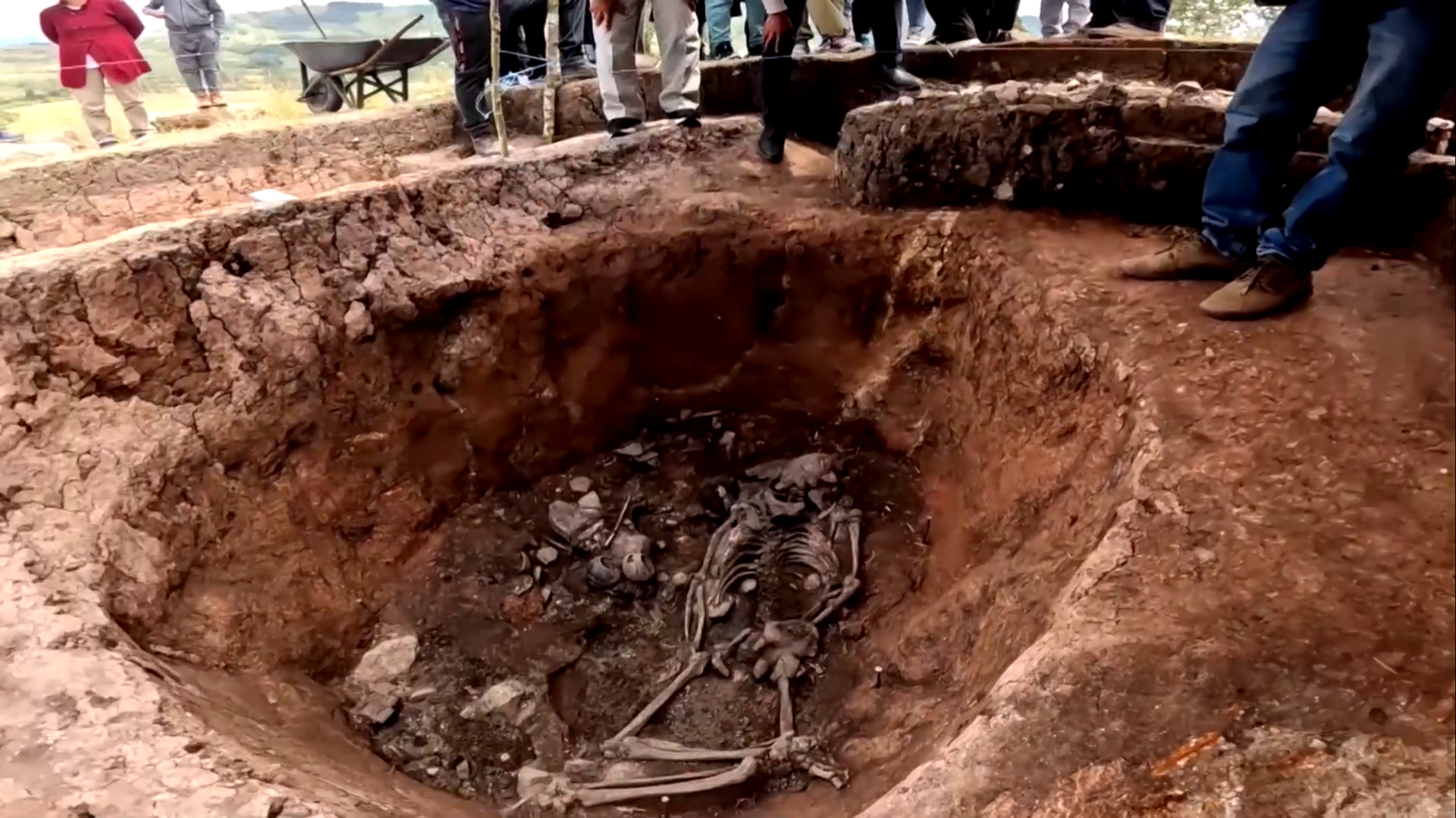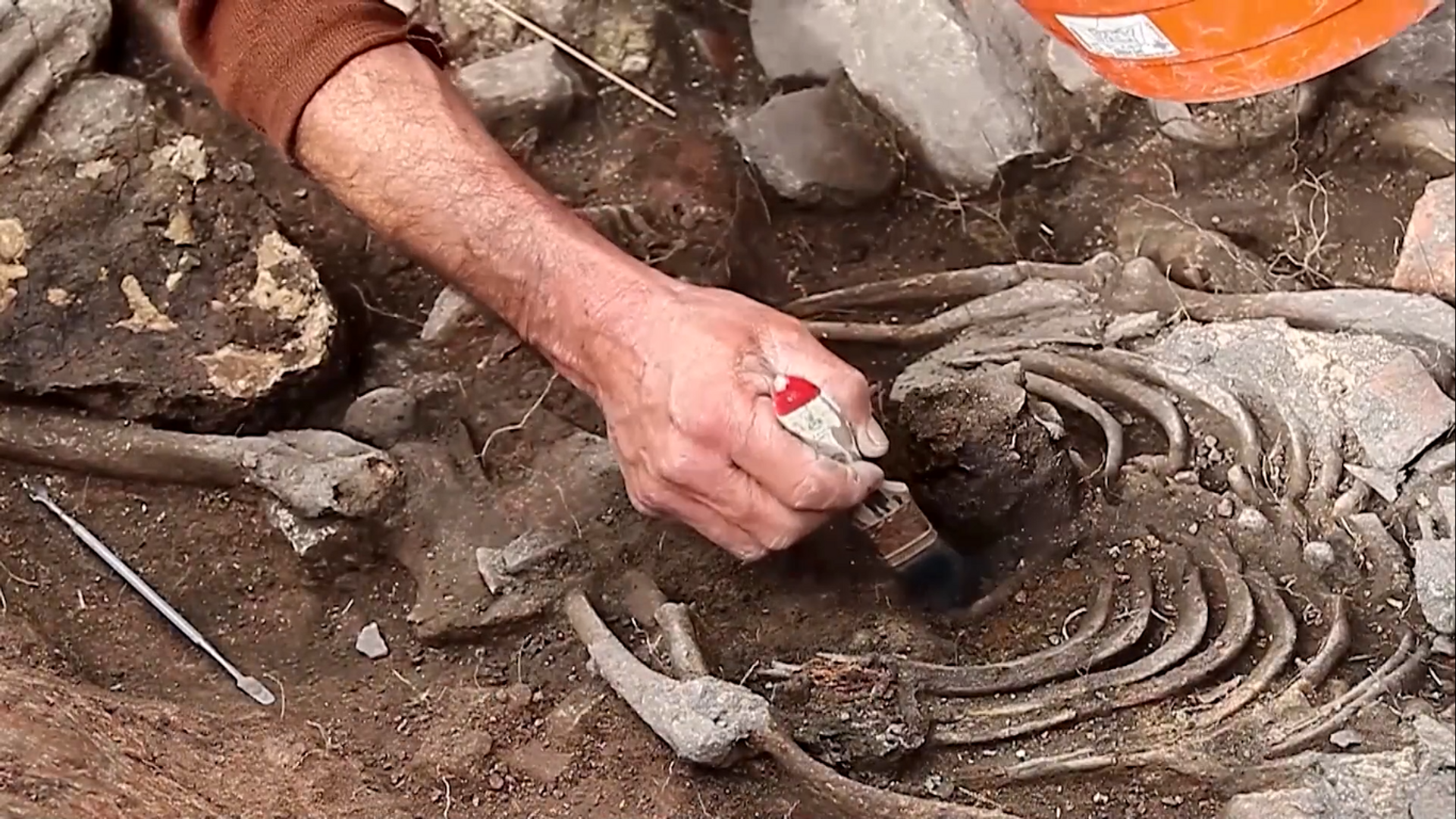https://sputnikglobe.com/20230830/archaeologists-unearth-3000-year-old-peruvian-tomb-housing-priests-remains-1112976521.html
Archaeologists Unearth 3,000-Year-Old Peruvian Tomb Housing Priest's Remains
Archaeologists Unearth 3,000-Year-Old Peruvian Tomb Housing Priest's Remains
Sputnik International
The body of the priest was found in lying in a strange position, said one of the researchers. Ceramic bowls, emblems, and other objects were also found buried alongside his body.
2023-08-30T03:56+0000
2023-08-30T03:56+0000
2023-08-30T03:55+0000
beyond politics
archeology
tomb
peru
ancient tombs
ancient history
https://cdn1.img.sputnikglobe.com/img/07e7/08/1e/1112976680_1:0:1366:768_1920x0_80_0_0_8ab8bb23e19b66102c0b95c5ec6669a6.png
Archaeologists in northern Peru have discovered a 3,000-year-old tomb, the country’s Culture Ministry announced over the weekend. The Pacopampa Archaeological Project, which has been working to excavate the site since 2005 and made the big reveal on Sunday, has revealed that the tomb’s remains belong to a priest.The “Priest of Pacopampa,” named in reference to the archaeological zone where his tomb was found, was buried around 1,200 BC. The priest, who was buried under six layers of ash mixed with black earth, is believed to have been an elite religious leader in the Andean country.The upper edge of the tomb had been adorned with two seals or emblems, and was decorated with ceramic bowls. Both the ceramic bowls and the seals were painted with the same substance applied to people’s bodies during ancient rituals, which only elite members of the society participated in. One seal depicts an anthropomorphic face looking east, while the other depicts a jaguar looking west.One thing in particular stood out to one of the archeologists about this tomb: its size. Yuji Seki, the project leader, said it was nearly two meters (2.2 yards) in diameter and meter (3.3 feet) deep. Seki said the large size was “very peculiar” and noted that the position of the body was also strange as the priest's body was found lying face down with one half of it extended and his feet crossed.Along with the remains, researchers also found a bone carved into the shape of a tupu, a pin worn by women in the Andes in order to fasten their textile garments.According to Peru’s Culture Ministry, the Priest of Pacopampa is about five centuries older than the tombs of the “Lady of Pacopampa,” which was discovered in 2009, and is also older than the “Serpent Jaguar Priest” unearthed in 2015. The “Lady of Pacopampa" died in 750 BC, while the “Serpent Jaguar Priest" died in 700 BC.Still, the “Priest of the Pututos'” tomb is older than this most recent discovery, the ministry says. The "Priest of the Pututos" was first discovered last year, and dates back to 1,000 BC.
peru
Sputnik International
feedback@sputniknews.com
+74956456601
MIA „Rossiya Segodnya“
2023
News
en_EN
Sputnik International
feedback@sputniknews.com
+74956456601
MIA „Rossiya Segodnya“
Sputnik International
feedback@sputniknews.com
+74956456601
MIA „Rossiya Segodnya“
ancient history, ancient tomb, peru, priest's tomb, archeology, priest of pacopampa, history, northern peru, south america
ancient history, ancient tomb, peru, priest's tomb, archeology, priest of pacopampa, history, northern peru, south america
Archaeologists Unearth 3,000-Year-Old Peruvian Tomb Housing Priest's Remains
The discovery of the tomb marks one of the oldest archeological discoveries in the area; however, officials have indicated that its age is not its most peculiar quality.
Archaeologists in northern Peru have discovered a 3,000-year-old tomb, the country’s Culture Ministry announced over the weekend.
The Pacopampa Archaeological Project, which has been working to excavate the site since 2005 and made the big reveal on Sunday, has revealed that the tomb’s remains belong to a priest.
The “Priest of Pacopampa,” named in reference to the archaeological zone where his tomb was found, was buried around
1,200 BC. The priest, who was buried under six layers of ash mixed with black earth, is believed to have been an elite religious leader in the Andean country.
The upper edge of the tomb had been adorned with two seals or emblems, and was decorated with ceramic bowls. Both the ceramic bowls and the seals were painted with the same substance applied to people’s bodies during ancient rituals, which only elite members of the society participated in.
One seal depicts an anthropomorphic face looking east, while the other depicts a jaguar looking west.
One thing in particular stood out to one of the archeologists about this tomb: its size. Yuji Seki, the project leader, said it was nearly two meters (2.2 yards) in diameter and meter (3.3 feet) deep. Seki said the large size was “very peculiar” and noted that the position of the body was also strange as the priest's body was found lying face down with one half of it extended and his feet crossed.
Along with the remains, researchers also found a bone carved into the shape of a
tupu, a pin worn by women in the Andes in order to fasten their textile garments.
“Though this person is a man, the associations are very peculiar,” Seki explained. “I think this was a leader in his time.”
According to Peru’s Culture Ministry, the Priest of Pacopampa is about five centuries older than the tombs of the “Lady of Pacopampa,” which was discovered in 2009, and is also older than the “Serpent Jaguar Priest” unearthed in 2015. The “Lady of Pacopampa" died in 750 BC, while the “Serpent Jaguar Priest" died in 700 BC.
Still, the “
Priest of the Pututos'” tomb is older than this most recent discovery, the ministry says. The "Priest of the Pututos" was first discovered last year, and dates back to 1,000 BC.



